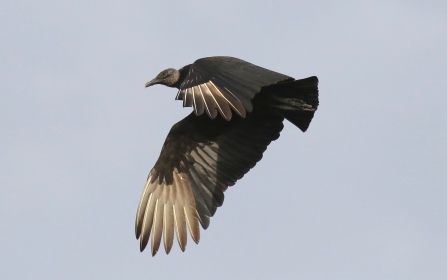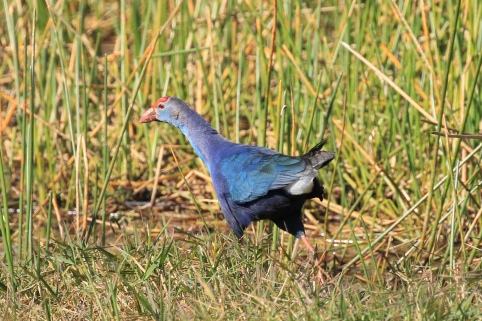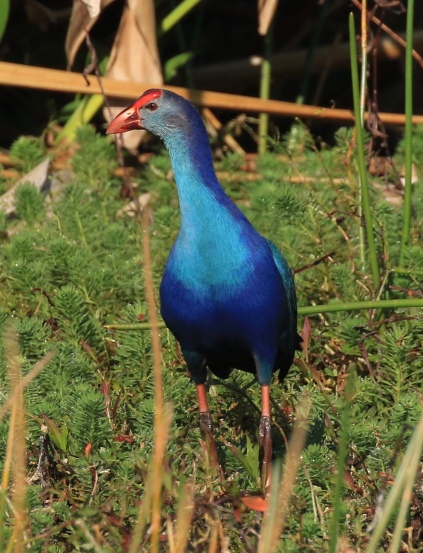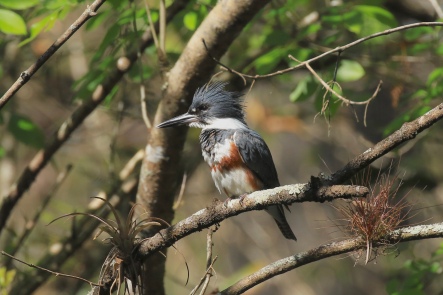Harns isn’t listed with the famous birding destinations in south Florida (Corkscrew, Ding Darling, the Everglades, and Big Cypress) but maybe it should be. This is a 578 acre preserve in Lehigh Acres set aside in 1985 for stormwater control along the Orange River. Half is an open water lake but the more interesting half for birders is the shallower marsh and surrounding trail. If you bird in the morning the sun will be at your back and allow some great shots of the waders and flyovers. Bring a scope as many of the birds tease you from a distance.
In my experience Harns is the best place to see Snail Kites. The imposing Sandhill Cranes approached me so closely I was a little worried about their intention, but it did allow some great closeups. The abundant non-native Apple Snails also attract Limpkins, while Bald Eagles, Harriers, Red-shouldered Hawks, Bitterns, and Vultures galore complemented the usual Florida waders. My personal life list here is 37, but locals report up to 100 species at Harns.
The reason for our recent visit was to chase the unusual Grey-headed swamphen (Porphyrio poliocephalus), listed on eBird as a rarity at this location. “Porphyrio” is Greek for purple, “polio” is Greek for grey, and “cephalus” is Latin for head. I had previously seen the bird only once at great distance and it was a life bird for my colleague. The large purple and blue bird was easily spotted among the grasses almost as soon as we arrived. The grey head was subtle if present at all. Apparently it is most obvious on the male; the female head is blue.
The swamphen saga in Florida is either one of escape and survival, or invasion and alarm depending on your point of view. The Purple swamphen is a native of Turkey, India, China, and Thailand and has recently been split into 6 separate species, the Grey-headed being one. There are two stories of the origin of this large tropical rail in south Florida. One account claims they escaped from the Miami Metro Zoo during hurricane Andrew in 1992. The other story blames careless aviculturalists allowing them to roam freely in Pembroke, Florida at about the same time. In any case the birds were sprung and made the most of their new freedom.
This bird has been described as “a Purple Gallinule on steroids”, it being much larger but otherwise quite similar to its native cousin. The non-migratory rail has quickly adjusted to the good life in the freshwater marshes of sunny Florida, primarily feasting on plants and supplementing the diet with mollusks, and small animals.
Up the food chain their threats are from alligators, large mammals, birds-of-prey, and for a while, man. The swamphens often raise several broods a year and their population has grown. With some alarm regarding their potential threats to the natives, authorities started a program of eradication, shooting 3100 birds over 27 months. This campaign ended in 2008 with the birds still surviving and thriving.
What do you think about the non-natives moving in? My feelings are colored by the Mute Swans that almost took over our tributary of the Chesapeake Bay several years ago. At their peak I could count several hundred of these alien, aggressive, non-migratory birds on the river with multiple nest along the shoreline. They were displacing the native, migratory, and more humble Tundra Swans and devouring the vital submerged grasses, roots and all. They clearly went too far when they attacked us in our canoe, (I fended them off with the paddle), and played chicken with me on the riding mower. Thankfully an eradication program ended all this and I have not seen one on the Chesapeake in years.
The jury’s still out on the swamphen. Can they assimilate and play well with others, or will they follow the lead of the Mute Swans and try to take over and dominate the Florida marshes? The bird is clearly a survivor. I admire that and so far I am not aware they have caused any substantial damage, but only time will tell. In the meantime, check out this photogenic bird and the other avifauna at Harns Marsh Preserve.









Your photos are stunning as always. I don’t feel qualified to judge if invasive species should be eradicated, it’s such a drastic measure. Species have always migrated and established themselves in new habitats, though probably never as easily as nowadays. I think it’s something biologists with a better understanding of the big picture and all the variables need to decide.
LikeLiked by 1 person
Thanks for your well-stated and wise comments.
LikeLiked by 1 person
Harns Marsh is one of my favourite SW Florida birding hotspots! I’ve never seen a Grey-headed Swamphen there though. It’s definitely a striking bird! As for non-natives moving in… these situations always have mixed results. We have a similar situation up here with the Mute Swans taking over and driving some native birds out. Difficult to know what to do in these circumstances, especially as many invasive species are introduced accidentally.
LikeLiked by 1 person
The Swamphen seems new at Harns this year. We saw several and I suspect they are moving in for the long haul. My impression is they are less invasive and obnoxious than Mute Swans. Thanks for your interest.
LikeLike
Between humans transporting and introducing non-native species both intentionally and unintentionally from around the globe there is certainly a shift in what species now dominate an area. Humans have also had an impact via climate change and bird feeders on many native species that no longer migrate. It will be interesting to see what happens with the Swamphen.
LikeLiked by 1 person
I like and agree with your observations. Homo sapiens is part of the biomass, however, impacting others just as we are impacted upon. Our evolution was never a sure thing, nor is our continued survival.
LikeLike
First, beautiful images. Do you ever shoot through the scope? Many up here do. As for the Mute swans and all birds that that nonnative, I know the damage and displacement they do, but I look at it from the perspective that it is not their fault they were brought here. They are just trying to survive like the native species. With warming climate, it is happening more often where species are moving to new regions or not migrating during winter. Same with plants. Food sources change as a result and the food source and migrant arrival dates are not coinciding. So the natives become non native somewhere else, and not always get the needed food. NYS proposed killing the Mute Swans. I suspect they did to some degree although they got backlash. Many birders agreed.
LikeLiked by 1 person
Thanks. I tried digiscoping without much luck. In a sense you are just substituting the scope for a good telephoto lens already interfaced with the camera. The rigamarole of mounting the camera on the scope just seemed a bridge too far for me. You’re right that it’s not the birds fault they were introduced and they’re just trying to survive. On the other hand the Mute Swan effect in our neck of the woods was quite severe and I’m glad they’re gone.
LikeLike
Nicely written and very interesting.
LikeLiked by 1 person
Thank you for your compliment and interest.
LikeLike
Beautiful photos! It looks a wonderful place to visit with many birds that I have never seen before but would love to. The Grey-headed swamphen first and foremost.
As for controlling invasive species I think it really depends on the individual situation. Some non-natives seem to blend into new habitats quite well without causing any major problems, while others can be incredibly destructive. The problem is often that by the time the impact of an invasive species is fully town it is too late to remove it. For this reason I would argue the situation but be closely monitored to see what happens.
LikeLiked by 1 person
Thank you. It think you’re right in saying it is usually too late to eradicate an invasive species. I’m rather surprised how well it has worked in the Chesapeake, though with the Mute Swans. It clearly failed with the Swamphen.
LikeLike
If you want to see substantial damage, go to Delray and see what remains of Wakodahatchee Wetlands as well as Green Cay. Just find pictures of the plant life and it’s disappearance as the bird eats it’s way through the native grasses upon which all other plant life was rooted
LikeLiked by 1 person
Thanks for that update. I don’t make it to that coast frequently; sorry to hear of the damages.
LikeLike